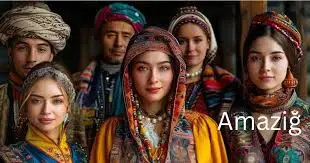The Amaziğpeople, sometimes referred to as Berbers, have a centuries-old cultural legacy that is rich and varied. A look into a distinct and resilient group may be gained from the Amaziğ culture, which includes their language and rituals.
Language and identity
The foundation of the AmaziĖ cultural identity is their language, Tamaziɗt. Throughout North Africa, people speak Tamazit with noticeable regional differences. The Tifinagh script captures the rich history and oral traditions of the Amazi people.
Traditional Beliefs and Practices
The Amazi have traditional beliefs that combine elements of Islam, animism, and regional traditions. Their customs, which include traditional dance, music, and ceremonies, are essential to maintaining their heritage. These customs frequently honor marriages, harvests, and ties to the land on a spiritual level.
Art and Crafts
Amazič craftsmen are well known for their skill in jewelry-making, weaving, and ceramics. These elaborate decorations frequently feature geometric patterns and culturally significant symbols. The Amazi people tell tales of resiliency, identity, and community via their artwork.
Historical Significance
The Amazič people have had difficulties with numerous invaders and colonial forces throughout history. They have, nevertheless, clung to their unique cultural customs and rejected attempts at integration. Gaining knowledge of their past helps one appreciate their ongoing cultural resilience.
Contemporary Challenges and Revival Efforts
Amazič communities work hard to maintain their cultural legacy in the face of urbanization and globalization nowadays. Cultural festivals, language revitalization initiatives, and campaigning for the recognition of their rights are among the efforts. The future generations’ ability to continue Amazi traditions depends on these activities.
Challenges in Preserving Amaziğ Cultural Heritage
The modern era presents various obstacles for the preservation of Amazič cultural legacy. Among these are the effects of globalization, which put traditional languages and customs in jeopardy as younger generations adopted more contemporary ways of living. Additionally, political marginalization and disregard for AmaziĖ rights hamper efforts to preserve cultural heritage. Initiatives such as language revitalization programs, cultural festivals, and the promotion of cultural rights within national and international frameworks address these issues.
Language Endangerment: dangers to Tamazi’s survival brought on by globalization and the dominance of certain languages.
Economic pressures: the impact of socioeconomic circumstances on the transmission of cultural practices to newer generations.
Education and Awareness: We must prioritize promoting Amaziğ dialects, customs, and history in public discourse and formal education.
Amaziğ Contributions to World Civilization
The Amazi people have contributed significantly to world culture with their artistic, scientific, and linguistic creations. Tamazit is one of the oldest indigenous languages in North Africa, with a linguistic heritage that preserves ancient cultural and historical knowledge. The elaborate motifs found in Amazi ceramics, weaving, and jewelry making are indicative of their artistry and cultural symbolism.
Art and Architecture: Impact on the elaborately designed and skillfully crafted ornamental arts and architecture of North Africa.
Science and mathematics: contributions made throughout history to agriculture, mathematics, and astronomy.
Literature and Oral Tradition: Oral tradition preserves poetry, heroic epics, and cultural narratives.
Geographical Distribution
The Amaziğ people inhabit North Africa, dispersed across nations such as Algeria, Morocco, Tunisia, Libya, and parts of Egypt.Amaziğ populations live in a variety of environments within these regions, including coastal plains, hilly regions, and desert oases. Over the years, geographical diversity has shaped their cultural traditions, way of life, and interactions with adjacent ethnic groups.
Religious practices and festivals
Over the years, geographical diversity has shaped their cultural traditions, way of life, and interactions with adjacent ethnic groups.In addition to customary rites honoring the natural world, ancestors, and seasonal cycles, they also observe Islamic rituals. Festivals like the Yennayer New Year celebration and the Imilchil Marriage Festival in Morocco mark important cultural and religious milestones. These celebrations feature a colorful blend of Amazič-specific cultural expressions, community meetings, and spiritual devotion.
Cuisine and Culinary Traditions
The food of the Amazi people is a reflection of their rich agricultural past and nomadic habits. Couscous, tagine, and other breads made from grains produced nearby are staple dishes. The use of flavorful spices like saffron, cumin, and coriander gives their food a unique taste. Slow cooking in earthenware pots is one of the traditional cooking techniques that emphasizes a close relationship to the land and sustainable food practices. Amazič cuisine is a cultural emblem of hospitality and communal sharing, in addition to being a source of nourishment for the body.
Gender Roles and Family Structures
In Amaziğ society, both modern and historical traditions influence gender roles and family patterns.Traditionally, women were essential to managing households and maintaining cultural customs through oral traditions, while men frequently held leadership positions in communities. Women have made significant contributions to a number of professions today, including politics, education, and cultural engagement. Family structures place a high emphasis on extended kinship networks, which encourage close ties and shared duties between relatives.
Impact of Globalization on Amaziğ Culture
Amazi culture has had both possibilities and challenges as a result of globalization. The promotion of cultural rights, educational opportunities, and cross-cultural exchange have all been made easier by increased connections. But as younger generations adopt new lifestyles and digital media, globalization has also presented challenges to old languages and habits. Cultural festivals, language revitalization initiatives, and struggles to have indigenous rights recognized by national and international institutions are some of the ways that Amazič cultural heritage is being protected.
Music and Dance: Expressions of Identity
Dance and music are essential components of Amaziğ identity, acting as displays of resistance and cultural pride. Rhythmic melodies are accompanied by traditional instruments like the guembri, a three-stringed lute, and the bendir, a frame drum.
Conclusion
Examining the Amazi people’s cultural legacy reveals a rich tapestry of customs, language, artwork, and resilience. The Amazi community continues to celebrate and protect their identity despite modern obstacles and their ancient heritage. We help preserve the diversity of cultures around the world by acknowledging and valuing their rich cultural heritage.
FAQS
The language used by the AmaziĖ people, sometimes referred to as Berbers, is AmaziĖ. It is an essential component of their cultural identity and is written in the Tifinagh script.
The Imilchil Marriage Festival in Morocco and the Yennayer New Year celebration are two examples of traditional Amaziğ festivities that emphasize cultural and religious value through group meetings and customs.
AmaziĖ cuisine consists of basic dishes like tagine and couscous that are made utilizing traditional techniques and flavorful spices. It represents warmth, sustainability, and a close bond with the soil.
In the past, women ran houses and upheld cultural customs, while men frequently occupied leadership positions. In addition to traditional positions, women’s achievements in a variety of professions are now being acknowledged more and more.
While globalisation presents difficulties for traditional languages and customs, it also offers chances for advocacy and cross-cultural exchange. Language revitalization and cultural advocacy programs are two ways that Amaziğ cultural heritage is being preserved.




